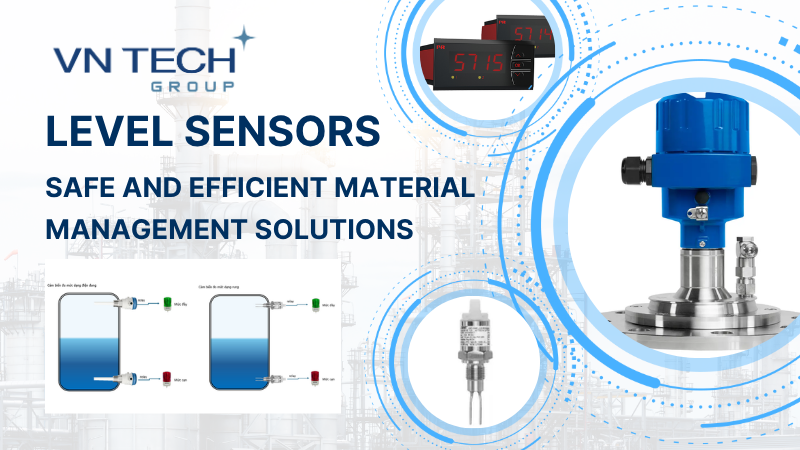
Level sensors are essential devices in most industries such as water treatment, oil and gas, food processing, chemicals, mining, cement, and more. They play a key role in accurately measuring the level of liquids (water, oil, chemicals) or solids (powder, granules, cement, grains) in tanks, silos, containers, or pipelines—thereby ensuring stable production operations, preventing loss, and avoiding downtime.
TYPES OF LEVEL SENSORS
In industrial applications, level sensors are generally classified into two main types, each with its own advantages and functions:
POINT LEVEL SENSOR (Point Level Detection Sensor)
Function:
• Provides a signal only when the material level reaches a predetermined threshold (either high or low).
• Does not perform continuous level measurement; operates based on discrete “presence/absence” detection.
Applications:
• Prevents dry run of pumps when the tank is empty.
• High-level alarm to prevent tank overflow.
• Enables automatic control: start/stop pumps, open/close valves, or trigger audible/visual alarms.
Operating Principle:
• When the material comes into contact with the sensor probe, the sensor activates an output signal (Relay, SPDT, or PNP) to control external devices.
Common Technologies:
- Rotary Paddle: A rotating paddle stops when it comes into contact with the material, triggering a microswitch.
- Vibrating Fork (Tuning Fork): The vibration frequency of the fork changes when it comes into contact with the material.
- Capacitive: Detects changes in capacitance when the material is present near the sensing probe.
- Optical: Uses infrared light to detect the presence or absence of material at a specific level.
- Conductive (Electrode/Rod): Utilizes two or more electrodes; an electrical current flows when a conductive liquid bridges the electrodes.
- Float (Floating Ball): A float mechanism changes position with the material level and activates a proximity switch or magnetic contact.
- Radiation (Gamma Ray): Uses nuclear radiation (typically gamma rays) to penetrate material; the intensity received changes depending on the presence or absence of material.
Practical Examples:
• Level indication (high, low, or intermediate) in liquid tanks to control material supply (via valves or pumps), protect pumps from dry running, or trigger alarms for operators when the tank is empty or overfilled.
• High-level detection in grain silos to stop material feeding (e.g., conveyors, rotary valves), or to activate alarms when the silo is either empty or overfilled.
Advantages:
- Simple design and easy installation.
- Low initial investment cost.
- Reliable operation with minimal maintenance requirements.
Limitation:
Only monitors fixed level points; does not provide continuous level measurement data.
CONTINUOUS LEVEL SENSOR
Function:
• Continuously measures the level of liquids or solids inside tanks or silos.
• Provides data in percentage or actual height values (e.g., 75%, 3 meters, etc.).
Applications:
• Inventory management of raw materials.
• Automatic control of pumps, valves, and feeding systems.
• Integration with remote monitoring systems such as PLC, SCADA, or IoT platforms.
Operating Principle:
• Measures the distance from the sensor to the surface of the material or calculates level based on pressure.
• Outputs analog signals (4–20mA, 0–10V) or communicates via Modbus RTU protocol.
Common Technologies:
- Ultrasonic: Emits ultrasonic waves and measures the time of flight for reflection.
- Radar: Uses high-frequency electromagnetic waves to measure the distance to the material surface; highly accurate even in dusty, steamy, high-pressure environments or tanks with internal obstructions (e.g., agitators, ladders) or foam.
- Hydrostatic Pressure (Glass Tube Type): Measures liquid column height through pressure sensing; suitable only for open tanks.
- Continuous Capacitive: Measures changes in capacitance along the probe length.
- Laser: Uses laser beams to measure distance to material surface.
- Differential Pressure: Measures the pressure difference between two points of the tank to determine the liquid level; applicable for both open and closed tanks.
- Radiation (Gamma Ray): Uses nuclear radiation (typically gamma rays) to penetrate the material; detected intensity changes depending on material presence or absence.
Practical Examples:
• Measuring clean water and wastewater levels in treatment tanks.
• Monitoring cement silos, grain silos, and FO/DO oil tanks.
• Integration with batching and dosing systems.
Advantages:
- Provides real-time, continuous measurement of liquid and solid levels.
- Easy integration into automated monitoring and control systems.
- Enables real-time inventory tracking and process optimization.
- Measurement accuracy depends on the technology used and operating conditions.
Limitations:
Higher investment cost compared to point level sensors.
Requires periodic maintenance and calibration—especially in corrosive or dusty environments.
WHICH LEVEL SENSOR SHOULD YOU CHOOSE?
- If your needs are limited to full/empty detection for pump/valve control or overflow alarms, point level sensors are a cost-effective and easy-to-install solution.
- If you require continuous process control or real-time monitoring, continuous level sensors offer better automation and labor savings.
VNTECH GROUP – GERMAN & EUROPEAN LEVEL MEASUREMENT SOLUTIONS – RELIABLE & EFFICIENT
VNTECH GROUP is the official distributor of UWT, Rechner Sensors, BD Sensors (Germany), and Yokogawa – global leaders in level measurement technology.
- Wide range of point and continuous level sensors
- Expert consultation tailored to your application and budget
- Genuine warranty and lifetime technical support
📞 Contact Us Now for Consultation
Hotline: 0918 113 733
Website: www.vntechgroup.vn
VNTECH GROUP – Helping You Monitor Material Levels Safely, Efficiently, and Intelligently!




